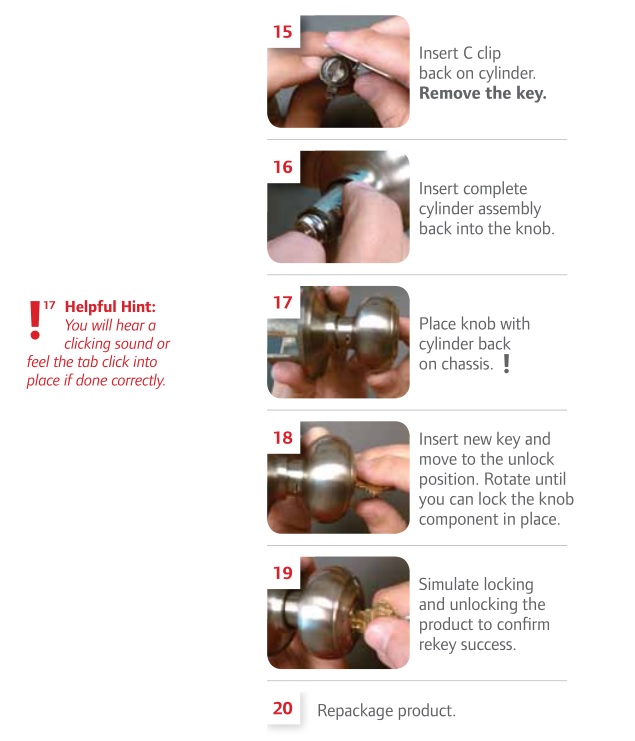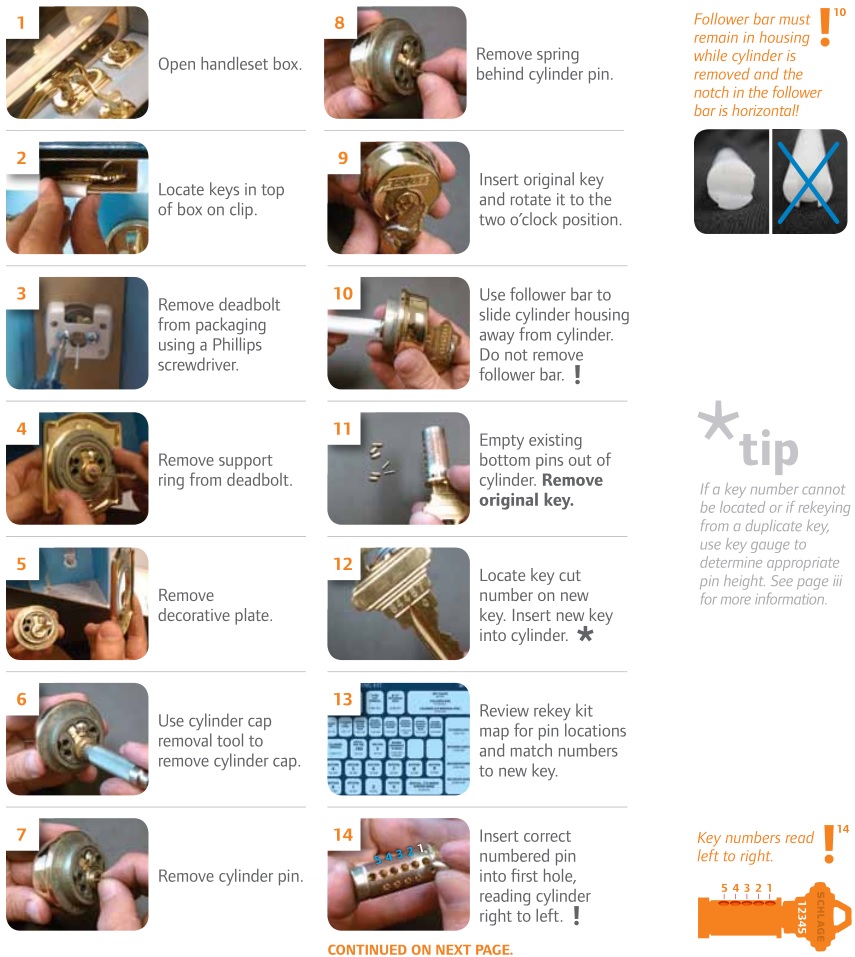Rekeying and Rekeying Kit User Manual

Rekeying Quick Start Guide
INTRODUCTIONRekeying and Rekeying Kit
SECTION 1Lever Rekeying
SECTION 2Knob Rekeying
SECTION 3Deadbolt Rekeying
SECTION 4Keypad Lock Rekeying
SECTION 5Keypad Deadbolt Rekeying
SECTION 6Handleset Rekeying
SECTION 7AppendixCylinder Repinning, Disengagement,Glossary of Terms
Rekeying
Rekeying: What You Need to Know
Rekeying is a precise process that requires expertise—particularly when it involves rekeying multiple products. By offering this service at your store, you’re helping customers make their keys match by taking advantage of the safest and most reliablerekeying method on the market.
In this guide, you’ll find detailed, easy-to-follow instructions for rekeying any Schlage lock cylinder. Each section—organized by product function—includes a list of features and benefits to help guide your conversation with customers and reinforce their choice in Schlage—the one most trusted by consumers.
Additionally, you’ll find expanded product views that outline the components of each product, as well as helpful hints and quick tips to further your knowledge of Schlage products. All of this is designed to support your role as a key resource, both to consumers and in-store.
Recommend Electronic Locks and Change a Code Not KeysIf you sense managing keys is becoming a challenge for your customer, you may want to recommend a Schlage keypad lock.
- Schlage Keypad Deadbolts: Consumer Digest Best Buy for two years running
- Schlage Keypad Levers: ideal for doors with a single-hole prep
More and more customers are finding that our keyless products are much more convenient…not to mention a better investment over the long run with no more keys to lose, hide, carry or forget. Best of all, they can unlock their door—at any time—with a simple four-digit code they designate.
When security really matters and your reputation is on the line, recommend Schlage products.
DID YOU KNOW?

The Schlage keypad deadbolt is a manual throw deadbolt because the engineers at Schlage wanted to ensure the deadbolt locks securely in place even as doors contract and expand from temperature and humidity changes outside. Rated ANSI Grade 2 by BHMA, Schlage Keypad Locks provide great security for residential openings.
Which Comes First?Rekeying Multiple Products
When you are rekeying multiple products to match a key in one of the packages (not a key from the customer), you can reduce the amount of time required by strategically choosing the order in which you rekey. For instance, if you are rekeying a handleset and a knob, rekey the knob to match the keys in the handleset package. This will take you less time.

REKEYING TIME

Lots of Products to Rekey?
Remind your customer that changing codes on a keypad lock or keypad deadbolt is a lot easier than changing keys or rekeying locks. In fact, on keypad locks, keys are only needed if customers ignore the low battery warning and the battery expires.
Rekeying from a Duplicate Key
Use caution when using a duplicate (aftermarket) key in the rekeying process. Duplicate keys wear faster and can result in key cut discrepancies during the rekeying process that cause the cylinder to stick when locked and unlocked after the cylinder is repinned.
Helpful Hint:Advise your customers to have additional keys made with the correct key cuts so they have a new key that functions smoothly in the rekeyed lock.
Reminder: While you are rekeying to the duplicate key, make sure all of the bottom pins in the cylinder are completely flush. (You may have to substitute smaller or larger pins if the duplicate key is too worn.)
If you are rekeying from a duplicate, follow these steps:
Use the Key Gauge to Determine Pin Combinations
- With key cuts facing up, slide key into the opening of key gauge, located near the number “0.” Move key to first cut, or notch, from the key bow.
- Slide key left until it stops on a number.
- Write down number and proceed to the next cut.
- Repeat until all cuts have a corresponding number—from bow to the tip of key. This five- or six-digit number is the key combination or “bitting.”

Helpful Hint:If the key lands between two numbers, pick the lower number (shallower cut).
Keying Kit
Schlage Rekeying Kits provide everything you need to get the job done—including all the tools and parts you need for repinning the cylinders of most Schlage locksets so that they work with a single key.
The following tools are included in the Keying Kit:

THE KIT MAP
Navigating your way through the Kit tray.
PARTS LIST:
- Bottom pins
- Top pins
- Springs
- Cylinder caps
- Cap pins
- Cap pin springs
- B-Series deadbolt tailpieces
- Key gauge
- Plug follower
- Cylinder cap removal tool
- Follower bar

LEVER REKEYING INSTRUCTIONS
Carefully remove the lever from the package by unsnapping the tabs in the upper corners of the clamshell.


KNOB REKEYING INSTRUCTIONS
Carefully remove the knob from the package by unsnapping the tabs in the upper corners of the clamshell.


DEADBOLT REKEYING INSTRUCTIONS


KEYPAD LOCK REKEYING INSTRUCTIONS


KEYPAD DEADBOLT REKEYING INSTRUCTIONS
Carefully remove the keypad deadbolt from the box.


HANDLESET REKEYING INSTRUCTIONS


Cylinder Repinning
Compressible cylinders can also be rekeyed from the top of the cylinder by following these easy steps:

Disengagement of Top Pins and Springs

Glossary of Terms
ANSIAmerican National Standards Institute.
backsetThe distance from the edge of door to the center line of prep.
bottom pinA bullet-shaped tumbler that comes in a variety of lengths that correspond to the depths of the key cuts.
chassisThe body of the lock itself, without any trim.
cylinderThe portion of a lock comprised of the plug, shell, pins (tumblers) and springs. A properly cut key allows the plug to rotate the tailpiece or drive mechanism which unlocks the lock.
handThe direction a door swings, always referenced from the outside. housing A larger portion of some cylinder assemblies which encases the cylinder (plug and shell).
latchboltA spring operated bolt with a beveled face to permit latching action when door closes.
master pinA cylindrical-shaped tumbler which is flat on both ends, placed between the top and bottom pin to create an additional shear line.
pin tumblerToday’s standard tumbler mechanism consists of a series of bottom pin, mechanism top pin and spring for each cut (notch) of the key.
pin tumblersSmall sliding pins in a lock cylinder that work against coil springs. They prevent the cylinder plug from rotating unless all are aligned simultaneously by cuts of the proper depths in the key.
plugThe portion of a cylinder which contains the keyway and rotates with the key.
roseA circular trim plate attached to the door under the knob or lever.
shear lineThe area where the top surface of the cylinder plug and inside surface of the shell meet, and the height to which the bottom pins must be raised by the key in order to rotate the plug.
shellThe portion of the cylinder immediately surrounding the plug.
strikeThe metal plate recessed in the frame that receives latch or bolt when the door is closed.
top pinA cylindrical-shaped tumbler which is flat on both ends and is installed directly under a coil spring in its chamber.
tailpieceA usually flat actuator which extends from the back of the cylinder plug and engages in the lock to operate the latch or bolt.
Rekeying and Rekeying Kit User Manual – Rekeying and Rekeying Kit User Manual –
[xyz-ips snippet=”download-snippet”]


